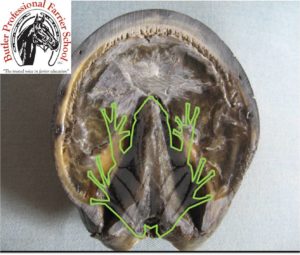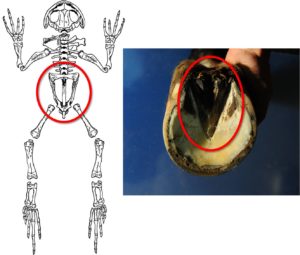The Horse’s Frog

The frog of the horse’s foot is the insensitive, wedge-shaped cushion or pad. Its purpose is to help the horse with shock absorption, blood circulation and traction.
The horse’s foot is a bio-mechanical marvel with many parts. Each part has a function. One of the most interesting parts is the frog. The frog is an insensitive, wedge shaped cushion or pad that helps the horse with shock absorption, traction and circulation. It is also a scent gland.
The exact etymology of how the frog gets its name is unknown but there are several different theories. In his Manual of Veterinary Physiology (1921), Smith calls this structure a “foot-pad” but concedes that it is “vulgarly known” as the “frog.”
One of the most widely accepted theories of how the frog got its name has to do with superstition. In olden times, horsemen would carry the bone of a frog (the amphibian) in their pocket as a good luck charm. The frog pelvis resembles the shape of the foot structure on the horse. Many believe that it became a colloquialism to refer to the hoof part as a frog because of the belief that horses feet and specifically horseshoes also carry good luck. It isn’t known just when horsemen started referring to the hoof structure as a frog, but it is apparent that the two look alike. Other theories state that the frog (hoof structure) is found under the hoof in the same way the amphibious frog might hide under a rock (Equus, August 1985) or that in dryer weather, the frog of the horse tends to dry out and shrivel up much like an amphibious frog would without water (fantasiacarriage.com).

The pelvic bone of the amphibious frog was carried by horsemen as a good luck charm. The bone resembles the structure of the foot. Many believe this is where the hoof structure got its name.
The frog is made up of the same type of horn that comprises the hoof wall. The difference is that there is more moisture in the frog. The moisture is supplied by environment as well as by the sensitive frog (blood supply). Some barefoot advocates have insisted that “the frog is inherently stronger than the hoof wall” because it is made up of “weird stuff [that] can’t be rasped back.” They make this assumption because in their rationale, the hoof wall can easily be rasped back, but the frog cannot. Therefore, they conclude the frog is stronger and must bear the majority of the horse’s weight. The conclusion is not complete though because it doesn’t take into consideration the moisture content of each structure. (David Farmilo, ABC Hoofcare, 2014, 52-53) The hoof wall has approximately half the moisture content of the frog. It is like saying a dry oak log is weaker than a soggy piece of oak bark because one is easily filed and the other is not. A piece of frog that is trimmed away from the horse dries out after 2 or 3 days and becomes more rigid.
The high moisture content of the frog (approximately 50%) allows for a spongy cushion that helps reduce concussion as the horse’s foot comes into contact with the ground. The frog itself is soft but it is also housed directly under the digital cushion, a fibro-fatty structure that also helps to reduce concussion. Some horses have large frogs that come in contact with the ground; other horses have very weak recessed frogs. It is a benefit to have a large frog but not absolutely necessary for the frog to touch the ground. Much of the shock absorption needed is to relieve pressure coming downward (from the weight of the horse down onto the digital cushion and then frog); not from pressure coming upward (from the ground to the frog). It is a mistake to try to get all horses’ frogs in contact with the ground by trimming too much heel. Every horse has a different hoof angle and this must be considered when trimming in order to prevent a broken-back axis and navicular pain.
Circulation is also aided by the frog. However, the frog itself is not a pump. The frog, along with other elastic structures of the foot compress networks of veins to push deoxygenated blood back out of the foot after it has been pumped in by the heart. Again, it has been proven that the frog does not need to come into contact with the ground in order to successfully push blood out of the foot (Chris Colles, Equine Veterinary Journal, 1983, 15:297; Equus, October 1989). This is because the downward compression of the bone against the digital cushion and other elastic structures is sufficient to circulate blood.
The frog is also useful to the horse as a traction device and scent gland. The wedge shape of the frog and rubbery consistency is useful for traction. Not all frogs are created equal so the amount of traction will vary depending on the condition of the frog. The frog is a scent gland just like the chestnut on the leg and ergot on the digit of the horse (A. Fischer, Der Fuss des Pferdes, 1927). This is why dogs can track horses. Horses often look for other horses in the pasture by calling out as well as sniffing the ground.
The frog should be trimmed or “neatened” on a regular schedule. The frog grows at the nearly the same rate as the hoof wall but exfoliates or “sheds” as a unit two or more times a year. When trimming the frog it is most important to trim the sides of the frog so that the channels on either side of the frog (called commissures) can be cleaned easily. The farrier holds the hoof knife perpendicular to the bottom of the foot to cut back any excess growth over the commissures. The farrier should not aggressively trim the frog by holding the knife at acute angles. The groove in the center of the frog is called the central sulcus or commonly known as the “cleft.” The trimmed frog should resemble the sensitive frog in shape while leaving enough material for for the frog to perform its shock-absorbing function.
If the frog is not trimmed regularly, excessive growth can trap manure and other filth in the commissures and create a welcoming environment for thrush. Thrush is an anaerobic bacteria that feeds on the horny structure of the frog. It is black in color and usually causes the frog to become crumbly and stinky. In severe cases, the bacteria can make its way into the sensitive structures of the foot and cause bleeding and subsequent infection. Infection in the blood (septicemia) can kill the animal. For this reason, thrush should not be ignored. Most of the time, thrush is mild and can be treated easily by regularly cleaning the horse’s hoofs with a hoof pick. Because thrush is anaerobic, simply exposing it to air causes it to die. There are several thrush medications that can be used in more chronic, severe cases of thrush.
Related Posts
-
As an American farrier that has shod horses from coas...Dec 13, 2016 / 0 comments
-
Many problems with horses are caused by horse-loving people....Mar 14, 2019 / 0 comments
-
The best way to tell the position of the Distal Phalanx, or ...Feb 20, 2010 / 0 comments
Blog Categories
- Anatomy
- Best Business Practices
- Conformation
- Current Events
- Customer Service
- Draft Horse Shoeing
- Equine Soundness
- Essential Anatomy Kit
- Farrier Careers
- Farrier training
- Foal soundness
- Horse Care
- Horse Foot Care
- Horse Owner Tips
- Horsemanship
- Horseshoeing
- Horseshoeing History
- Iron and Forge Work
- Student Spotlight
- Uncategorized
- Veterinary Care
Blog Archives
Contact Us
Butler Professional Horseshoeing School
495 Table Road
Crawford, NE 69339
(800) 728-3826
jacob@dougbutler.com
Subscribe to Our Blog
Get Our Free e-Book!
If you think you want to become a farrier (or know someone who does), this book can help you make that decision. Horse owners will learn the importance of choosing a qualified farrier and how to select the “right” one.
[ Get the e-Book Now! ]
- Follow:
